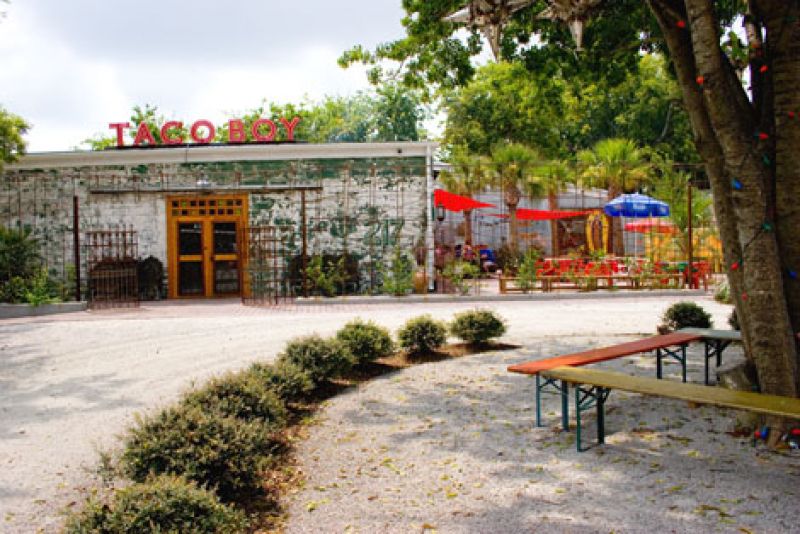
The masked bandito is in full view, his oversize noggin grinning at the base of the Ravenel Bridge. The Taco Boy mascot has reason to smirk: his downtown namesake opened in May on Huger Street, the culmination of 18 months of planning and a dream long in the making. Revolutionary Eating Ventures, REV for short—the muscle behind Poe’s Tavern, Monza, and Taco Boy’s fraternal twin on Folly Beach—wanted a place with the emphasis trained on sustainability and environmentally conscious measures, i.e., no shortcuts. As Kermit says, it ain’t easy being green, but for REV partners Karalee Nielsen and Tim Mink, it’s absolutely worth it—from the reduction in carbon emissions to anticipated energy savings. They managed to fulfill the majority of their eco-friendly short list—most everything has been either rehabbed or rescued, right down to the fallen North Carolina walnut tree that serves as the bar counter. The upshot: Taco Boy has been serving packed houses all summer long. “As things in the economy started to tank, it made me feel even more grateful that we were able to make this work and that people flocked through the doors to see the vision and be part of it,” Nielsen says. Tasty Mexican food always helps, but for Nielsen and Mink, the way they went about constructing the restaurant, formerly a bread distribution warehouse, is a point of satisfaction. They added a living fence, gave the patio a porous overlay to sift rainwater runoff back into the water table, and used reclaimed materials throughout the space. “That was part of the challenge of doing this restaurant,” Nielsen concedes. “When we said, ‘We’re going to do this as sustainably as we can,’ that forced us to think about every detail.” REV tabled a few high-end green dreams on its ultimate wish list—for instance, the electricity-producing wind turbines. Time-prohibitive, Nielsen says; otherwise, they’d still be waiting to open. REV considered solar energy but determined the number of panels required to power Taco Boy would take up the entire parking lot. And about the parking lot—the rear yard was to be planted with an organic garden, a plan that had to be reassessed because of the traffic volume. “We never expected we would need 100 parking spaces,” Nielsen says. Right now, REV is working to secure nearby land for the garden to be cultivated in conjunction with local schools, perhaps as an after-school program. So do any of these revisions make Taco Boy less green? Hardly. Once the plantings grow, the 12-foot-high living fence, supported by rebar, will help clean the air, reduce noise, and function as a privacy buffer. The patio’s pervious surface allows rainwater to return to the water table instead of overburdening the city’s sewers. “During a storm, it puddles for a second,” Nielsen explains, “then it’s gone.” A rainwater capture system—which collects precipitation in several 50-gallon barrels—makes use of the recycled water for landscaping purposes. And a series of on-demand tankless water heaters contributes to better efficiency and lower utility costs. Yet, most striking are the foraged bits and pieces scattered about the taqueria. REV and the firm Kevan Hoertdoerfer Architects carried out a de facto scavenger hunt to outfit the restaurant. The doors, light fixtures, tables, chairs, and brightly colored block windows were all recovered from an Atlanta warehouse prior to its demolition. The patio picnic tables came from a German beer hall, artist Jeff Kopish crafted the clever aluminum can lights, and Mink and Nielsen unearthed the gates connecting the green screen. Heck, even the large rectangular kitchen window, allowing ample natural light, was plucked from the storefront of Monza. “That’s one of my favorite features,” Nielsen says. Plus, Taco Boy curtailed its carbon footprint by installing recycled vinyl wall treatments in the outdoor bathroom corridor and another recycled material, the same used in hospital recovery rooms, on the kitchen walls. And the new part of the building structure is made from insulated concrete forms, which offer a high energy-efficiency rating. Upcoming plans include constructing a storage shed, which will permit recyclable and compostable materials to be separated from trash, a practice that has considerably cut waste at REV’s other restaurants. And the sustainable showstopper: this fall, Taco Boy’s “green roof”—an 18-inch-thick sod installation to help control temperature and decrease heating and cooling costs—should be complete. How much money REV might save, Nielsen can’t say yet. With a capacity of 300, Taco Boy is twice as large as Poe’s Tavern and the Taco Boy on Folly Beach, which each accommodate about 150 people. “We just don’t have another restaurant this size to compare,” she says. Give it a year, she continues, for the square footage costs to be analyzed. In the meantime, it’s just a tremendous measure of pride. “I was so emotional when we were finally finished,” Nielsen says. “At the end of the day, it’s about doing the right thing.”